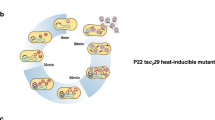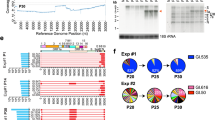Abstract
THE development of colivirus T7 is largely independent of host cell functions and dependent on T7-encoded enzymes, for example, T7 RNA polymerase, DNA replication enzymes, and lysozyme1,2. In view of this relative independence, the failure to propagate in Escherichia coli cells carrying an F factor3,4 or in anucleate minicells5 is particularly interesting with respect to a molecular understanding of host–virus interaction. We report here that T7 can, at a low frequency, productively infect both F+ cells and minicells derived from either an F+ or an F− E. coli culture. The percentage of T7 permissive cells within an F+ population is dependent on the growth conditions of the culture but does not seem to be directly related to a specific phase of the cell cycle.
This is a preview of subscription content, access via your institution
Access options
Subscribe to this journal
Receive 51 print issues and online access
$199.00 per year
only $3.90 per issue
Buy this article
- Purchase on Springer Link
- Instant access to full article PDF
Prices may be subject to local taxes which are calculated during checkout
Similar content being viewed by others
References
Schweiger, M. & Herrlich, P. Curr. Topics Microbiol. Immun. 65, 59–132 (1974).
Hausmann, R. Curr. Topics Microbiol. Immun. 75, 77–110 (1976).
Dettori, R., Macaccaro, G. A. & Piccinin, G. L. Gen. Microbiol. 9, 141–150 (1961).
Mäkelä, O., Mäkelä, P. H. & Soikkeli, S. Ann. Med. exp. Biol. Fenn. 42, 188–195 (1964).
Rogerson, A. C. Biochem. biophys. Res. Commun. 66, 665–670 (1975).
Ponta, H. et al. Eur. J. Biochem. 59, 261–270 (1975).
Ryter, A., Shuman, H. & Schwartz, M. J. Bact. 122, 295–301 (1975).
Begg, K. J. & Donackie, W. D. J. Bact. 129, 1524–1536 (1977).
Ponta, H. et al. Molec. gen. Genet. 149, 145–150 (1976).
Condit, R. C. J. molec. Biol. 98, 45–56 (1975).
Britten, J. R. & Haselkorn, R. Proc. natn. Acad. Sci. U.S.A. 72, 2222–2226 (1975).
Condit, R. C. & Steitz, J. A. J. molec. Biol. 98, 31–43 (1975).
Reeve, J. N. & Cornett, J. B. J. Virol. 15, 1308–1316 (1975).
Ponta, H. et al. Molec. gen. Genet. 134, 281–297 (1974).
Frazer, A. C. & Curtiss, R. III, Curr. Top. Microbiol. Immun. 69, 1–84 (1974).
Mertens, G. & Reeve, J. N. J. Bact. 129, 1198–1207 (1977).
Reeve, J. N. J. Bact. 131, 363–365 (1977).
Levy, S. B. Proc. natn. Acad. Sci. U.S.A. 72, 2900–2904 (1975).
Herrlich, P., Rahmsdorf, H.-J., Pai, S. H. & Schweiger, M. Proc. natn. Acad. Sci. U.S.A. 71, 1088–1092 (1974).
Studier, F. W. Virology 39, 562–574 (1969).
Author information
Authors and Affiliations
Rights and permissions
About this article
Cite this article
PONTA, H., REEVE, J., PFENNIG-YEH, M. et al. Productive T7 infection of Escherichia coli F+ cells and anucleate minicells. Nature 269, 440–442 (1977). https://doi.org/10.1038/269440a0
Received:
Accepted:
Issue Date:
DOI: https://doi.org/10.1038/269440a0
This article is cited by
-
Bacteriophage ϕ29 infection of Bacillus subtilis minicells
Molecular and General Genetics MGG (1980)
-
Radiation sensitivity of messenger RNA
Molecular and General Genetics MGG (1979)
-
Bacteriophage infection of minicells
Molecular and General Genetics MGG (1977)
Comments
By submitting a comment you agree to abide by our Terms and Community Guidelines. If you find something abusive or that does not comply with our terms or guidelines please flag it as inappropriate.



